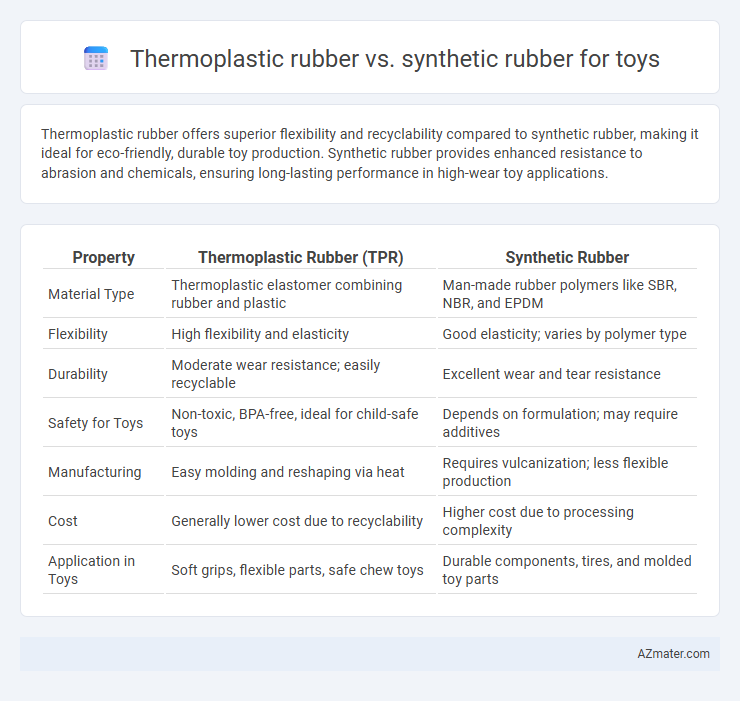Thermoplastic rubber offers superior flexibility and recyclability compared to synthetic rubber, making it ideal for eco-friendly, durable toy production. Synthetic rubber provides enhanced resistance to abrasion and chemicals, ensuring long-lasting performance in high-wear toy applications.
Table of Comparison
| Property | Thermoplastic Rubber (TPR) | Synthetic Rubber |
|---|---|---|
| Material Type | Thermoplastic elastomer combining rubber and plastic | Man-made rubber polymers like SBR, NBR, and EPDM |
| Flexibility | High flexibility and elasticity | Good elasticity; varies by polymer type |
| Durability | Moderate wear resistance; easily recyclable | Excellent wear and tear resistance |
| Safety for Toys | Non-toxic, BPA-free, ideal for child-safe toys | Depends on formulation; may require additives |
| Manufacturing | Easy molding and reshaping via heat | Requires vulcanization; less flexible production |
| Cost | Generally lower cost due to recyclability | Higher cost due to processing complexity |
| Application in Toys | Soft grips, flexible parts, safe chew toys | Durable components, tires, and molded toy parts |
Introduction to Thermoplastic Rubber and Synthetic Rubber
Thermoplastic rubber (TPR) combines the elasticity of rubber with the recyclability and processing advantages of plastics, making it ideal for toys requiring durability and flexibility. Synthetic rubber, typically derived from petrochemicals like styrene-butadiene or nitrile, offers high resilience and chemical resistance but often requires vulcanization to achieve desired properties. Choosing between TPR and synthetic rubber depends on factors such as manufacturing efficiency, safety standards, and the specific tactile and durability requirements of toys.
Key Properties of Thermoplastic Rubber
Thermoplastic rubber (TPR) offers superior elasticity, durability, and chemical resistance compared to synthetic rubber, making it ideal for toy manufacturing. Its ability to soften upon heating allows for efficient recycling and reshaping, reducing environmental impact. TPR also provides excellent tensile strength and a non-toxic, hypoallergenic surface, ensuring safety and longevity in children's products.
Key Properties of Synthetic Rubber
Synthetic rubber offers superior elasticity, durability, and resistance to abrasion, making it ideal for toys requiring flexibility and longevity. Its excellent resistance to chemicals, oils, and temperature variations ensures safety and maintains performance under diverse conditions. The material's ability to retain softness and flexibility over time enhances the tactile experience for children while meeting stringent safety standards.
Safety Considerations for Toy Manufacturing
Thermoplastic rubber (TPR) offers enhanced safety in toy manufacturing due to its non-toxic, hypoallergenic properties and compliance with stringent international toy safety standards like ASTM F963 and EN71. Synthetic rubber, while durable, may contain additives or plasticizers that can pose health risks if not carefully regulated, increasing potential exposure to harmful chemicals such as phthalates. Choosing TPR minimizes concerns regarding biocompatibility and chemical migration, ensuring safer, more eco-friendly toys for children.
Durability and Longevity in Toys
Thermoplastic rubber (TPR) offers exceptional durability and resistance to deformation, making it ideal for toys subjected to frequent bending and stretching. Synthetic rubber, such as styrene-butadiene rubber (SBR) or nitrile rubber (NBR), provides superior abrasion resistance and resilience, enhancing the longevity of toys exposed to rough play environments. Both materials ensure safety compliance and extended lifespan, but TPR's ability to be easily molded and recycled gives it an edge in sustainable toy manufacturing.
Flexibility and Texture Comparison
Thermoplastic rubber offers superior flexibility with a soft, smooth texture ideal for toys that require repeated bending and squeezing without deformation. Synthetic rubber provides a firmer texture and higher durability, suitable for toys needing more resistance to abrasion and impact. The choice depends on the desired tactile experience; thermoplastic rubber ensures a gentle, pliable feel, while synthetic rubber delivers robustness with moderate flexibility.
Environmental Impact and Sustainability
Thermoplastic rubber (TPR) offers significant environmental advantages over synthetic rubber in toy manufacturing due to its recyclability and lower energy consumption during processing. TPR's ability to be melted and reshaped multiple times reduces waste and supports circular economy principles, unlike many synthetic rubbers that are thermoset and non-recyclable. The sustainable sourcing of raw materials and reduced emissions associated with TPR production further enhance its appeal for eco-friendly toy applications.
Cost-Effectiveness in Toy Production
Thermoplastic rubber (TPR) offers superior cost-effectiveness in toy production due to its recyclability and ease of processing, which reduces manufacturing cycle times and waste. Synthetic rubber, while providing excellent durability and flexibility, tends to incur higher costs from more complex curing processes and limited recyclability. The choice between TPR and synthetic rubber hinges on balancing upfront material expenses against long-term savings in waste management and production efficiency.
Popular Applications in the Toy Industry
Thermoplastic rubber (TPR) is widely used in the toy industry for items like flexible action figures, soft grips, and chewable teething toys due to its recyclable nature and ease of molding. Synthetic rubber, particularly silicone and styrene-butadiene rubber (SBR), is preferred for durable toys such as balls, rubber ducks, and non-toxic sensory toys because of its resistance to wear and chemical stability. Both materials support safety and flexibility requirements, but TPR dominates applications requiring softness and recyclability while synthetic rubber excels in longevity and performance under stress.
Conclusion: Choosing the Right Material for Toys
Thermoplastic rubber offers excellent flexibility, durability, and ease of molding, making it ideal for toys requiring intricate shapes and vibrant colors. Synthetic rubber provides superior elasticity and resistance to wear and environmental factors, suitable for toys exposed to rough play and outdoor conditions. Selecting the right material depends on the toy's intended use, safety standards, and desired longevity, with thermoplastic rubber favored for detailed designs and synthetic rubber for robust performance.

Infographic: Thermoplastic rubber vs Synthetic rubber for Toy
 azmater.com
azmater.com